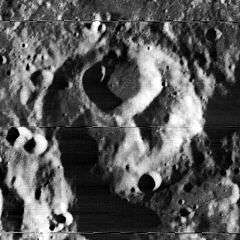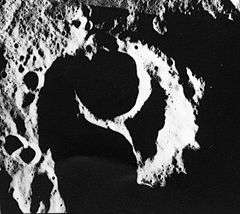Wilsing (crater)
Wilsing is a lunar impact crater on the far side of the Moon. It lies due north of the crater Plummer, and farther to the north of the huge walled plain Apollo. Wilsing is located just inside the rim of the immense South Pole-Aitken basin.
 Lunar Orbiter 1 image | |
| Coordinates | 21.5°S 155.2°W |
|---|---|
| Diameter | 73 km |
| Depth | Unknown |
| Colongitude | 155° at sunrise |
| Eponym | Johannes Wilsing |

This is a heavily worn formation with the smaller satellite crater Wilsing Z lying prominently across the northern half of the interior floor. The rim of Wilsing bulges outward along the northeastern face, and there are a few small craterlets along the rim to the west and south. The interior floor is somewhat uneven, with the most level portion being in the south-southwest.
Satellite craters
By convention these features are identified on lunar maps by placing the letter on the side of the crater midpoint that is closest to Wilsing.
| Wilsing | Latitude | Longitude | Diameter |
|---|---|---|---|
| C | 19.0° S | 153.0° W | 33 km |
| D | 20.0° S | 152.6° W | 15 km |
| R | 22.5° S | 157.5° W | 24 km |
| T | 21.3° S | 159.9° W | 19 km |
| U | 20.6° S | 158.9° W | 26 km |
| V | 20.5° S | 158.2° W | 51 km |
| W | 18.5° S | 159.8° W | 36 km |
| X | 17.4° S | 157.4° W | 23 km |
| Z | 20.9° S | 155.2° W | 30 km |
References
- Andersson, L. E.; Whitaker, E. A. (1982). NASA Catalogue of Lunar Nomenclature. NASA RP-1097.CS1 maint: ref=harv (link)
- Blue, Jennifer (July 25, 2007). "Gazetteer of Planetary Nomenclature". USGS. Retrieved 2007-08-05.CS1 maint: ref=harv (link)
- Bussey, B.; Spudis, P. (2004). The Clementine Atlas of the Moon. New York: Cambridge University Press. ISBN 978-0-521-81528-4.CS1 maint: ref=harv (link)
- Cocks, Elijah E.; Cocks, Josiah C. (1995). Who's Who on the Moon: A Biographical Dictionary of Lunar Nomenclature. Tudor Publishers. ISBN 978-0-936389-27-1.CS1 maint: ref=harv (link)
- McDowell, Jonathan (July 15, 2007). "Lunar Nomenclature". Jonathan's Space Report. Retrieved 2007-10-24.CS1 maint: ref=harv (link)
- Menzel, D. H.; Minnaert, M.; Levin, B.; Dollfus, A.; Bell, B. (1971). "Report on Lunar Nomenclature by the Working Group of Commission 17 of the IAU". Space Science Reviews. 12 (2): 136–186. Bibcode:1971SSRv...12..136M. doi:10.1007/BF00171763.CS1 maint: ref=harv (link)
- Moore, Patrick (2001). On the Moon. Sterling Publishing Co. ISBN 978-0-304-35469-6.CS1 maint: ref=harv (link)
- Price, Fred W. (1988). The Moon Observer's Handbook. Cambridge University Press. ISBN 978-0-521-33500-3.CS1 maint: ref=harv (link)
- Rükl, Antonín (1990). Atlas of the Moon. Kalmbach Books. ISBN 978-0-913135-17-4.CS1 maint: ref=harv (link)
- Webb, Rev. T. W. (1962). Celestial Objects for Common Telescopes (6th revised ed.). Dover. ISBN 978-0-486-20917-3.CS1 maint: ref=harv (link)
- Whitaker, Ewen A. (1999). Mapping and Naming the Moon. Cambridge University Press. ISBN 978-0-521-62248-6.CS1 maint: ref=harv (link)
- Wlasuk, Peter T. (2000). Observing the Moon. Springer. ISBN 978-1-85233-193-1.CS1 maint: ref=harv (link)